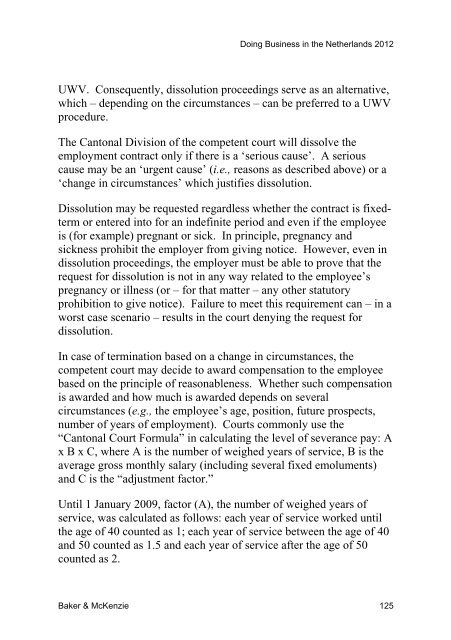Doing Business in the Netherlands 2012 - American Chamber of ...
Doing Business in the Netherlands 2012 - American Chamber of ...
Doing Business in the Netherlands 2012 - American Chamber of ...
You also want an ePaper? Increase the reach of your titles
YUMPU automatically turns print PDFs into web optimized ePapers that Google loves.
<strong>Do<strong>in</strong>g</strong> <strong>Bus<strong>in</strong>ess</strong> <strong>in</strong> <strong>the</strong> Ne<strong>the</strong>rlands <strong>2012</strong><br />
UWV. Consequently, dissolution proceed<strong>in</strong>gs serve as an alternative,<br />
which – depend<strong>in</strong>g on <strong>the</strong> circumstances – can be preferred to a UWV<br />
procedure.<br />
The Cantonal Division <strong>of</strong> <strong>the</strong> competent court will dissolve <strong>the</strong><br />
employment contract only if <strong>the</strong>re is a ‘serious cause’. A serious<br />
cause may be an ‘urgent cause’ (i.e., reasons as described above) or a<br />
‘change <strong>in</strong> circumstances’ which justifies dissolution.<br />
Dissolution may be requested regardless whe<strong>the</strong>r <strong>the</strong> contract is fixedterm<br />
or entered <strong>in</strong>to for an <strong>in</strong>def<strong>in</strong>ite period and even if <strong>the</strong> employee<br />
is (for example) pregnant or sick. In pr<strong>in</strong>ciple, pregnancy and<br />
sickness prohibit <strong>the</strong> employer from giv<strong>in</strong>g notice. However, even <strong>in</strong><br />
dissolution proceed<strong>in</strong>gs, <strong>the</strong> employer must be able to prove that <strong>the</strong><br />
request for dissolution is not <strong>in</strong> any way related to <strong>the</strong> employee’s<br />
pregnancy or illness (or – for that matter – any o<strong>the</strong>r statutory<br />
prohibition to give notice). Failure to meet this requirement can – <strong>in</strong> a<br />
worst case scenario – results <strong>in</strong> <strong>the</strong> court deny<strong>in</strong>g <strong>the</strong> request for<br />
dissolution.<br />
In case <strong>of</strong> term<strong>in</strong>ation based on a change <strong>in</strong> circumstances, <strong>the</strong><br />
competent court may decide to award compensation to <strong>the</strong> employee<br />
based on <strong>the</strong> pr<strong>in</strong>ciple <strong>of</strong> reasonableness. Whe<strong>the</strong>r such compensation<br />
is awarded and how much is awarded depends on several<br />
circumstances (e.g., <strong>the</strong> employee’s age, position, future prospects,<br />
number <strong>of</strong> years <strong>of</strong> employment). Courts commonly use <strong>the</strong><br />
“Cantonal Court Formula” <strong>in</strong> calculat<strong>in</strong>g <strong>the</strong> level <strong>of</strong> severance pay: A<br />
x B x C, where A is <strong>the</strong> number <strong>of</strong> weighed years <strong>of</strong> service, B is <strong>the</strong><br />
average gross monthly salary (<strong>in</strong>clud<strong>in</strong>g several fixed emoluments)<br />
and C is <strong>the</strong> “adjustment factor.”<br />
Until 1 January 2009, factor (A), <strong>the</strong> number <strong>of</strong> weighed years <strong>of</strong><br />
service, was calculated as follows: each year <strong>of</strong> service worked until<br />
<strong>the</strong> age <strong>of</strong> 40 counted as 1; each year <strong>of</strong> service between <strong>the</strong> age <strong>of</strong> 40<br />
and 50 counted as 1.5 and each year <strong>of</strong> service after <strong>the</strong> age <strong>of</strong> 50<br />
counted as 2.<br />
Baker & McKenzie 125





![912.025 AmCham News [1] - American Chamber of Commerce in ...](https://img.yumpu.com/9328612/1/190x127/912025-amcham-news-1-american-chamber-of-commerce-in-.jpg?quality=85)

